Computer Networks Midterm
1/98
There's no tags or description
Looks like no tags are added yet.
Name | Mastery | Learn | Test | Matching | Spaced |
|---|
No study sessions yet.
99 Terms
Data Communication Circuit Switching:
End-end resources allocated to, reserved for “call” between - and -.
In a link that has 4 circuits, call gets - circuit in top link and - circuit in right link.
Deducated resources: _ _, circuit-like (guaranteed) performance
Circuit segment _ if not used by _.
Commonly used in traditional _ networks
source, destination, 2nd, 1st, no sharing, guaranteed, idle, call, telephone
Packet Switching - Characteristics:
1. Efficient: - used on - (vs. dedicated path of circuit switching). - -.
2. Generic: can used for - types of applications.
3. Out-of-order delivery: - not guaranteed to be the - for - packets
4. Contention: due to - resources: s-, l-, b-
5. Delay: packets may be -
resources, demand, statistical multiplexing, many, path, same, different, shared, switch, links, bandwidth, queued
Physical Media:
1. Signal: propagates between -/- pairs
2. physical link: what lies - transmitter and receiver.
3. guided media: signals propagate in - -. copper, fiber, coax
4. unguided media: signals propagate -. radio.
5. twisted pair (TP): two insulated - -. Category -: - mbps, - gpbs ethernet. Category -: - gpbs
transmitter, receiver, between, solid media, freely, copper wires, 5, 100, 1, 6, 10
Human protocols: -, -. Specific message -. Specific - taken when messages -, or other events
questions, introductions, sent, actions, received
Network Protocols: - rather than -. all communication - in - governed by a - of -
machines, humans, activity, internet, suite, protocols
protocols define -, - of messages - and - among network entities, and - - on message transmission, receipt - - and -
format, order, sent, received, actions taken, message syntax, semantic
Internet (TCP/IP) Protocol Stack (from top to bottom, order matters) (5):
application, transport, network, link, physical
Application: FTP, SMTP, HTTP
supporting network applications
Transport: TCP, UDP
process-process data transfer
Network: IP, routing protocols
routing of datagrams from source to destination
Link: Ethernet, 802.11 (WiFi), PPP
data transfer between neighboring network elements
Physical
bits “on the wire”
Access Networks: How to connect end systems to edge router?
residential access nets
institutional access networks (school, company)
mobile access networks
Access Networks: Considerations
bandwidth (bits per second) of access network?
shared or dedicated?
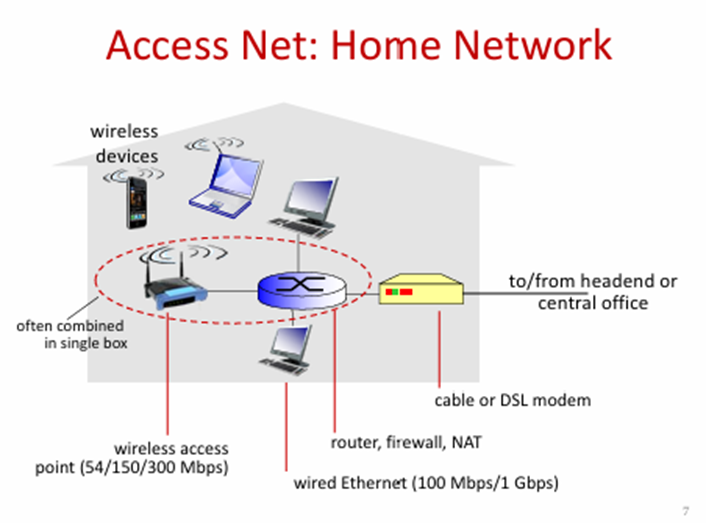
see image
Internet Structure: Network of Networks
End systems connect to Internet via - -
Access ISPs in turn must be -. so that any two hosts can send - to each other.
Resulting network of networks is very -. Evolution was driven by - and - -.
access ISPs, interconnected, packets, complex, economics, national policies
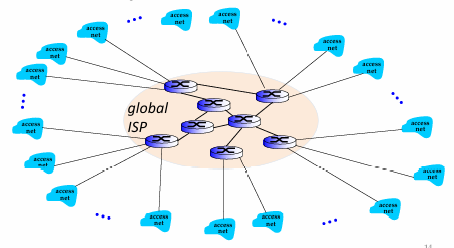
Option: connect each access ISP to a - - ISP? - and - ISPs have economic agreement
global transit, customer, provider
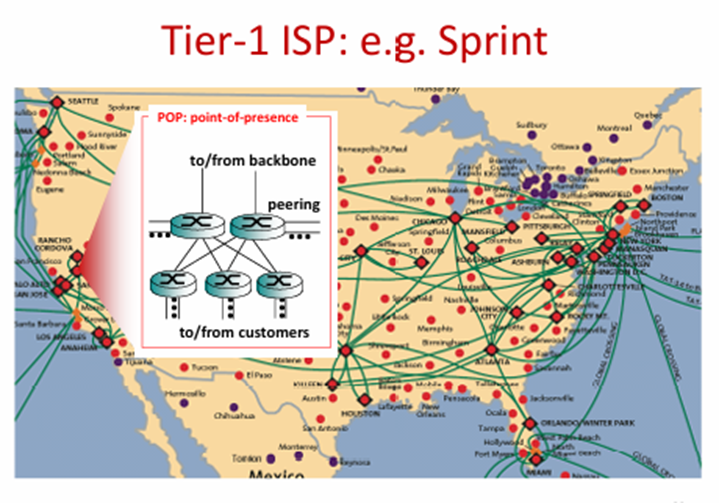
POP: point-of-prescence
Host: Sends packets of -.
Host sending function:
takes - message
breaks into smaller chunks, aka -, of - L bits
transmits packet into access network at - rate -.
link transmission rate aka link -, aka link -
packet transmission delay = time needed to transmit L-bit packet into link = L (bits)/R (bits/sec)
data, application, packets, length, transmission, R, capacity, bandwidth
Four sources of packet delay:
dproc: nodal processing
dqueue: queueing delay
dtrans = L/R: transmission delay
dprop = d/s: propagation delay
Add all those together to make dnodal
L = packet length (bits), R = link bandwidth (bps), d = length of physical link, s = propagation speed in medium (2×108 m/sec)
Packet Loss:
Queue (aka buffer) preceding link in buffer has - capacity
packet arriving to full queue - (aka loss)
lost packet may be retransmitted by - node, by source - system, or not at all
finite, dropped, previous, end
Throughput: rate (bits/time unit) at which - transferred between -/-
instantaneous: rate at - point of time
average: rate over - period of time
bits, sender, receiver, given, longer
Bottleneck link: link on end-end - that constrains end-end -
path, throughput
Bad guys: attack server, Network Infrastructure
Denial of Service (DoS): Attackers make resources (server, bandwidth) unavailable to legitimate traffic by overwhelming resource with - -.
1. Select -
2. break into - around the network
3. send - to target from - hosts
bogus traffic, target, hosts, packets, compromised
P2P Architecture
- always-on server
arbitrary end systems directly -
peers request service from other peers, provide service in return to other peers
Self scalability: new peers bring new service -, as well as new service -
peers are intermittently - and change - addresses
Complex management
no, communicate, capacity, demands, connected, IP
TCP Service: - - between sending and receiving process
reliable transport
TCP Service: sender wont overwhelm receiver
flow control
TCP Service: throttle sender when network overloaded
congestion control
TCP Service: - - - timing, minimum throughput guarantee, security
does not provide
TCP Service: setup required between client and server processes
connection-oriented
UDP Service: - - - between sending and receiving process
unreliable data transfer
UDP Service: - - -: reliability, flow control, congestion control, timing, throughput guarantee, security, or connection setup
does not provide
Protocol for Web Surfing: HTTP (hyper-text transfer protocol)
web page consists of -
object can be HTML file, JPEG image, Java applet, audio file,…
web page consists of base - which includes - - objects
each object is addressable by a -
objects, HTML-file, several referenced, URL
non-persistent HTTP issues:
requires 2 - per object
OS overhead for - TCP connection
browsers often open - TCP connections to fetch - -
RTTs, each, parallel, referenced objects
persistent HTTP:
server leaves connection - after sending response
subsequent HTTP messages between - client/server sent over open connection
client sends - as soon as it encounters a referenced object
as little as one - for all the referenced objects
open, same, requests, RTT
Uploading Form Input:
POST method:
- - often includes form input
input is uploaded to - in entity -
web page, server, body
Uploading Form Input:
URL method:
uses - method
input is uploaded in URL - of request line
GET, field
Transport Services and Protocols:
provide - - between app processes running on different hosts. App requires different -.
Transport protocols run in end systems
- side: breaks app messages into -, passes to - layer
- side: reassembles segments into -, passes to - layer
more than one transport protocols available to apps
internet: TCP (in-order, reliable) and UDP (unordered, unreliable
logical communication, services, send, segments, network, receive, messages, app
handle data from multiple sockets, add transport header (later used for demultiplexing).
multiplexing at sender
use header info to deliver received segments to correct socket.
de-multiplexing at receiver
TCP socket identified by a 4-tuple
-/- IP address
-/- port number
source, dest
receiver uses all four values to direct segment to appropriate socket
de-mux
web servers have - sockets for each connecting client
non-persistent HTTP will have - socket for each request
different
server host may support - simultaneous TCP sockets
many
memorize format
UDP Checksum
Goal: - "errors” (flipped bits) in transmitted segment
detect
UDP Checksum
Sender:
treat segment contents, including header fields, as sequence of _-bit integers
Checksum: _ (1-complement sum) of segment contents
sender puts checksum _ into UDP checksum field
16, addition, value
UDP Checksum
Receiver: (if received checksum is not all 0s)
_ checksum of received segment
check if computed checksum equals checksum field value:
No = _ detected
Yes = no _ detected
compute, error
Principles of Reliable Data Transfer
important in application, transport, link layers
What does rdt stand for?
characteristics of - channel will determine - of rdt
reliable data transfer protocol, unreliable, complexity
rdt2.0: Channel with Bit Errors:
underlying channel may flip bits in packet
how to recover from errors?
- (ACKs): receiver explicitly tells sender that pkt received OK
- - (NAKs): receiver explicitly tells sender that pkt had errors
New mechanisms in rdt2.0
- detection with checksum
-: controls msgs (ACK, NAK) from receiver to sender
acknowledgements, negative acknowledgements, error, feedback
rdt2.0 has a Fatal Flaw:
if ACK/NAK gets corrupted, sender doesnt know what happened at receiver and transmits current pkt if ACK/NAK corrupted which may lead to _ packets
handling and detection
sender adds - - to each packet
receiver checks - - and discards (doesnt deliver up) the -ed packet
duplicate, sequence number
sender sends one packet, then waits for receiver response (stops packet duplication)
stop and wait
rdt2.2: a NAK-free Protocol
same functionality as rdt2.1, using _ only
instead of _, receiver sends ACK for last pkt received OK.
duplicate ACK at sender results in same action as NAK: _ current pkt
ACKs, NAK, retransmit
rdt3.0: Channels with Errors and Loss
New assumption:
underlying channel can also lose packets (data, ACKs)
Approach:
sender waits “-” amount of time for ACK.
retransmits if no ACK received in this time
if pkt (or ACK) just delayed (not lost):
- will be duplicate, but seq. #’s already handles this
receiver must specify seq $ of pkt beind ACKed
requires - -
reasonable, retransmission, countdown timer
Performance of rdt3.0:
correct but _
network protocol limits use of _ resources
need to identify the cause and fix it: why _ is so low?
stinks, physical, utilization
Pipelined Protocols:
-: sender allows multiple, “in-flight”, yet-to-be-acknowledged pkts
range of seq. #’s must be increased
buffering at sender and/or receiver
no more stop and wait
generic form of ‘- -’ protocols
pipelining, sliding window
Pipelining Protocols:
_-_-_: sender can have up to N unack’ed packets in pipeline
receiver only sends _ ack
sender has timer for oldest unack’ed packet and when it expires, retransmit all unack’ed packets
go-back-N, cumulative
Pipelining Protocols:
- -: sender can have up to N unack’ed packets in pipeline
rcvr sends - ack for each packet
sender maintains timer for each unack’ed packet and when it expires, retransmit only that unack’ed packet
selective repeat, individual
retransmit packet n and all higher seq # pkts in window
timeout(n)
TCP: Overview
_-_-_: one sender, one receiver
point-to-point
TCP: Overview
reliable, in-order _ stream: no “message boundaries”
byte
TCP: Overview
-: TCP congestion and flow control set window size, sliding window
pipelined
TCP: Overview
- - -: bi-directional data flow in same connection. MSS: maximum segment size
full duplex data
TCP: Overview
- -: sender will not overwhelm receiver
flow controlled
TCP: Overview
_-_: handshaking (exchange of control msgs) initialized sender, receiver state before data exchange
connection-oriented
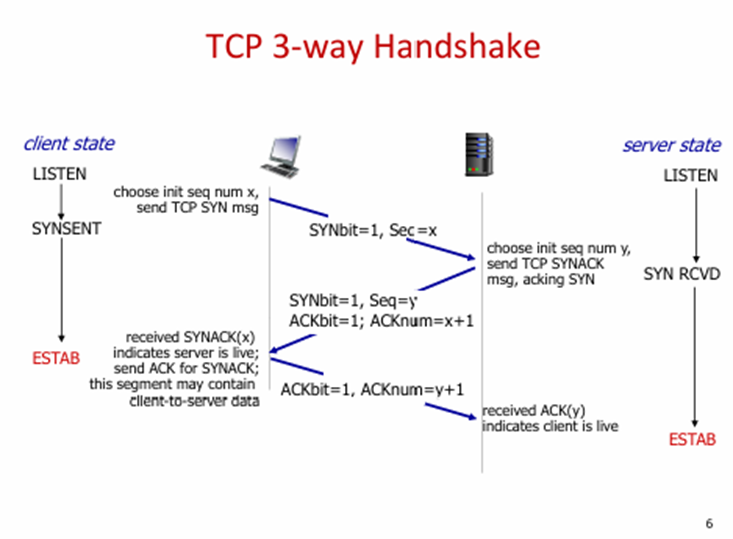
see image
TCP - -: byte stream “number” of first byte in segment’s data
sequence numbers
TCP -: seq # of next byte expected from other side. cumulative ACK
acknowledgements
how receiver handles out-of-order segments?
TCP spec doesnt say, up to implementation
TCP Round Trip Time, Timeout
timeout interval = - + - (safety margin)
estimatedRTT, 4*DevRTT
-: informally: “too many sources sending too much data too fast for network to handle”, different from flow control! caused by lost - and long -
congestion, packets, delays
TCP Congestion Control: additive increase
increase cwnd (congestion window) by 1 MSS every RTT until loss detected
TCP Congestion Control: multiplicative decrease
cut cwnd in half after loss
TCP Congestion Control: approach
sender increases transmission rate (window size), probing for usable bandwidth, until loss occurs
TCP Slow Start:
When connection begins, - rate - until first loss event
increase, exponentially
TCP: Detecting, Reacting to Loss
loss indicated by timeout: cwnd set to 1 - (TCP Tahoe) or is cut in - (TCP Reno). window then grows exponentially to threshold, then grows linearly
loss indicated by 3 duplicate ACKs: dup ACKs indicate network capable of delivering some segments → move to - recovery state. cwnd is set to threshold + -
threshold is set to 1/2 of - in both cases of loss
MSS, half, fast, 3, cwnd
Why is TCP fair?
- - -:
additive increase gives slope of 1, as throughput increases
multiplicative decrease decreases throughput proportionally
two competing sessions
-: determine route taken by packets from source to dest.
routing
-: move packets from router’s input to appropriate router output
forwarding
- network provides network-layer - service
datagram, connectionless
_-_: network provides network-layer _ service
virtual-circuit, connection
analogous to TCP/UDP connection-oriented/connectionless transport layer services, but:
-: host-to-host
- -: network provides only one
-: in network core
service, no choice, implementation
Virtual Circuits:
“source-to-dest path behaves like - circuit”
performance-wise
network actions along source-to-dest path
call setup, teardown for each call before data can flow
each packet carries VC identifier (not destination host address)
every router on source-dest path maintains “state” for each passing connection
link, router resources (bandwidth, buffers) may be allocated to VC (dedicated resources = predictable service)
telephone
when looking for forwarding table entry for given destination address, use longest address prefix that matches destination address
longest prefix matching
Router Architecture Overview:
two key router functions:
- - algorithms/protocol (RIP, OSPF, BGP) (software)
- datagrams from incoming to outgoing link (hardware
run routing, forwarding
IP Fragmentation, Reassembly:
network links have MTU (- - -) - largest possible link-level frame. different link types, different MTUs
Large IP datagram divided “fragmented” within net. one datagram becomes several datagrams. “reassembly” only at - destination. IP header used to identify, order related fragments
max transfer size, final
IP Addressing:
CIDR (c- i-d- r-)
- portion of address of arbitrary length
address format: a.b.c.d/x, where x is # bits in - subnet portion of address
classless interdomain routing, subnet
IP Addressing: CIDR
How to obtain the subnet part of an IP address?
using a subnet mask
DHCP: (d- h- c- p-)
-: allow host to dynamically obtain its IP address from network server when it joins network
can renew its lease on address in use
allows reuse of addresses (only hold address while connected/”on”)
support for mobile users who want to join network
dynamic host configuration protocol, goal
DHCP overview:
hosts broadcasts “DHCP -” msg [optional]
DHCP server responds with “DHCP -” msg [optional]
host requests IP address: “DHCP -” msg
DHCP server sends address: “DHCP -” msg
discover, offer, request, ack
DHCP can return more than just allocated IP address on subnet:
address of first-hop - for client
name and IP address of - server
- - (indicating network versus host portion of address)
router, DNS, network mask
NAT router must:
for - datagrams: replace (source IP address, port #) of every outgoing datagram to (NAT IP address, new port #)
for - datagrams: replace (NAT IP address, new port #) in dest fields of every incoming datagram with corresponding (source IP address, port #) stored in NAT table
remember (in NAT translation table) every (source IP address, port #) to (NAT IP address, new port #) translation pair
outgoing, incoming
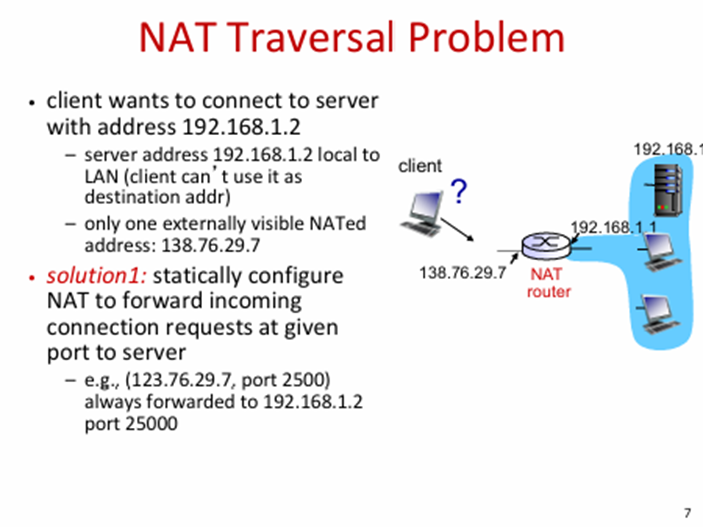
see image
ICMP stands for
internet control message protocol
ICMP is used by hosts & routers to communicate network-level information
- -: unreachable host, network, port, protocol
- -/-: used by ping
network-layer “-” IP: ICMP msgs carried in IP datagrams
ICMP message: -, - plus first 8 bytes of IP datagram causing error
error reporting, echo request/reply, above, type, code
IPv6 Motivation:
- -: 32-bit address space soon to be completely allocated
IPv6 d- f-:
fixed-length 40 byte header
no fragmentation allowed
initial motivation, datagram format
Transition form IPv4 to IPv6:
IPv6 datasgram carried as payload in IPv4 datagram among IPv4 routers is known as -
not all routers can be - simultaneously
no “- -”
tunneling, upgraded, flag days
Input Port Queueing:
fabric - than input ports combined → queuing may occur at input queues
queuing delay and loss due to input buffer -!
slower, overflow
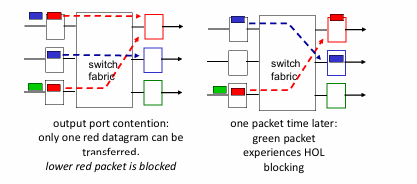
Input Port Queueing:
_-_-_-_ (HOL) -: queued datagram at front of queue prevents others in queue from moving forward
head-of-the-line blocking